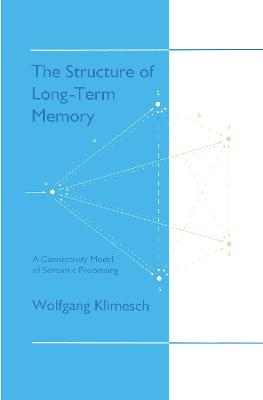
The Structure of Long-term Memory
A Connectivity Model of Semantic Processing
Seiten
1994
Psychology Press (Verlag)
978-0-8058-1354-8 (ISBN)
Psychology Press (Verlag)
978-0-8058-1354-8 (ISBN)
The connectivity model predicts that the speed of processing information increases as the amount and complexity of integrated knowledge increases. In this volume, this prediction is examined by analyzing the results of different experiments.
How is information stored and retrieved from long-term memory? It is argued that any systematic attempt to answer this question should be based on a particular set of specific representational assumptions that have led to the development of a new memory theory -- the connectivity model. One of the crucial predictions of this model is that, in sharp contrast to traditional theories, the speed of processing information increases as the amount and complexity of integrated knowledge increases. In this volume, the predictions of the model are examined by analyzing the results of a variety of different experiments and by studying the outcome of the simulation program CONN1, which illustrates the representation of complex semantic structures. In the final chapter, the representational assumptions of the connectivity model are evaluated on the basis of neuroanatomical and physiological evidence -- suggesting that neuroscience provides valuable knowledge which should guide the development of memory theories.
How is information stored and retrieved from long-term memory? It is argued that any systematic attempt to answer this question should be based on a particular set of specific representational assumptions that have led to the development of a new memory theory -- the connectivity model. One of the crucial predictions of this model is that, in sharp contrast to traditional theories, the speed of processing information increases as the amount and complexity of integrated knowledge increases. In this volume, the predictions of the model are examined by analyzing the results of a variety of different experiments and by studying the outcome of the simulation program CONN1, which illustrates the representation of complex semantic structures. In the final chapter, the representational assumptions of the connectivity model are evaluated on the basis of neuroanatomical and physiological evidence -- suggesting that neuroscience provides valuable knowledge which should guide the development of memory theories.
Klimesch, Wolfgang
Contents: Preface. Introduction. The Representational Problem: A Historical Perspective. Traditional Theories of Forgetting. The Failure of Traditional Forgetting Theories: Misleading Representational Assumptions. STM Codes: Their Structure and Decay. Network Theories: Basic Assumptions on the Structure of LTM. Strictly and Nonstrictly Hierarchical Models of Fact Retrieval. Strictly and Nonstrictly Hierarchical Models of Word Meaning. The Connectivity Model. A Connectivity Model for Semantic Processing. The Simulation Program CONN1. Representational Assumptions and Their Possible Neural Bases. Concluding Remarks.
| Erscheint lt. Verlag | 12.4.1994 |
|---|---|
| Verlagsort | Philadelphia |
| Sprache | englisch |
| Maße | 152 x 229 mm |
| Gewicht | 566 g |
| Themenwelt | Geisteswissenschaften ► Psychologie ► Allgemeine Psychologie |
| Geisteswissenschaften ► Psychologie ► Biopsychologie / Neurowissenschaften | |
| Naturwissenschaften ► Biologie ► Humanbiologie | |
| Naturwissenschaften ► Biologie ► Zoologie | |
| ISBN-10 | 0-8058-1354-3 / 0805813543 |
| ISBN-13 | 978-0-8058-1354-8 / 9780805813548 |
| Zustand | Neuware |
| Haben Sie eine Frage zum Produkt? |
Mehr entdecken
aus dem Bereich
aus dem Bereich
wie Affekte innere Entwicklung ermöglichen
Buch | Softcover (2023)
Klett-Cotta (Verlag)
CHF 41,95
Buch | Softcover (2024)
Hogrefe Verlag
CHF 46,50


